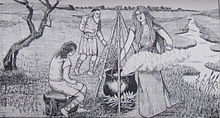Hanes Taliesin
Hanes Taliesin [ 'hanes tal'jesin ] ("The story of Taliesin") is the title of a story about the youth of the poet Taliesin . In the world chronicle of the Welsh Elys Gruffydd (* ~ 1490, † 1552) the oldest version of the legend is contained.
content
Gwion Bach [ gwion baːx ] ("Little Gwion"), a little boy or dwarf who works as a servant for the sorceress Ceridwen and her husband Tegid Foel, illegally tastes a magic potion that she had carefully prepared for a year. Her ugly son Morfran , also called Afaggdu, was to become beautiful and wise through him. Another version says that Gwion Bach burned his finger while stirring the hot drink and accidentally swallowed three drops of it by licking the wound. He thereby gains the gift of poetry and prophecy.
The angry Ceridwen pursues Gwion Bach, who tries to save himself by changing his shape several times. So he flees as a hare, she hunts him as a greyhound, etc. In the end, he turns into a grain of wheat that she picks up as a hen. In one version she becomes pregnant and gives birth to Gwion Bach in the figure of the poet Taliesin.
Another version says that it finally caught him and threw him into the sea in anger. Elffin, the son of King Gwyddno Garanhir , found and raised him on the coast of North Wales . He calls him Taliesin and under this name he becomes the most famous poet at the court of Gwynedd .
Modern reception
In the humorous novel Auch einer (1878) by Friedrich Theodor Vischer , in the chapter The Visit , which takes place in a stake village in Helvetia, the children sang the following song to the druid Angus:
- Gwyon, that little drip - what is it doing?
- Has licked the magic pot. Who come from
- Come on, alas! Oh dear! Coridwen, the strong fairy!
See also
- Myths and legends from Wales and Britain
- List of Celtic gods and legendary figures
- Celtic cauldron cult
- Llyfr Taliesin
- Macgnímartha Finn
literature
- Helmut Birkhan : Celts. Attempt at a complete representation of their culture. Publishing house of the Austrian Academy of Sciences, Vienna 1997, ISBN 3-7001-2609-3 .
- Bernhard Maier : Lexicon of Celtic Religion and Culture (= Kröner's pocket edition . Volume 466). Kröner, Stuttgart 1994, ISBN 3-520-46601-5 .
- Jan Fries: Cauldron Of The Gods: A Manual Of Celtic Magick. Mandrake, 2005. (books.google.at)
Web links
Individual evidence
- ↑ Helmut Birkhan: Celts. Attempt at a complete representation of their culture. P. 730.
- ↑ Helmut Birkhan: Celts. Attempt at a complete representation of their culture. P. 730.
- ↑ Helmut Birkhan: Nachantike Keltenrezeption. Praesens Verlag, Vienna 2009, ISBN 978-3-7069-0541-1 , p. 498.
- ↑ Friedrich Theodor Vischer: Also one: A travel acquaintance. tredition, 2011, ISBN 978-3-8424-2143-1 . (books.google.at)
